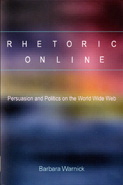Space
The last of the five parts of the communication process that Warnick examines in drawing qualitative distinctions between the Web and older media is space, in two related senses. First, the Web, through spatial metaphors such as "cyberspace," "Web site," "home page," "Web address," and others, is often imagined as a vast place in which the very real physical distances and cultural differences separating users are rendered secondary to a larger sense of community.
Second, as a result of the wide diversity of Web audiences, designers of Web artifacts must capture audience attention as soon as possible or the ever-wandering (note the metaphors) Web surfer, using his or her browser, will be soon off to other places. Warnick quotes Manovich here, who argues that "if there is a new rhetoric or aesthetic possible [with the Web], it may have less to do with the ordering of time by a writer or orator, and more to do with spatial wandering'" (qtd. in Warnick 41). Warnick explains that Web authors are obliged to devote much of their efforts simply to capture the wanderer's attention and keep him or her involved long enough for persuasion to be possible. Indeed, Lanham (2006) argues that the Internet is “a pure case of an attention economy” (17). The competition in this space is for eyeballs, because eyeballs are the gateways to hearts and minds.
The Payoff
At the end of this chapter, Warnick outlines a methodological payoff for her extended discussion of how the Web has refigured reception, source, message, time, and space. First, site design and usability provide windows into understanding how Web texts appeal to audiences’ heads, hearts, and guts, just as verbal style always has. Second, rhetorical critics might focus on how Web texts construct their users' identities and values. On sites that archive user comments, the dialectic between this construction and how it is received and used by audiences can be fleshed out through primary evidence. Third, interactivity affects invention. While sustained linear argumentation is not a typical feature of most Web texts, users' attention can be sustained through affordances that allow customization of individual site experiences and through the heightened levels of intertextuality that hyperlinked content and multimodality provide.
Now that Warnick has argued for the importance of understanding the Web on its own terms, and outlined a medium theory approach that could invigorate rhetorical criticism of Web artifacts, she turns her attention in the next three chapters to showing such an approach in action through the kinds of case studies she advocates. In the next chapter, Chapter 3, Warnick uses Stephen Toulmin's concept of field dependency in argumentative knowledge-making to examine how users judge the credibility of online rhetorical artifacts.
